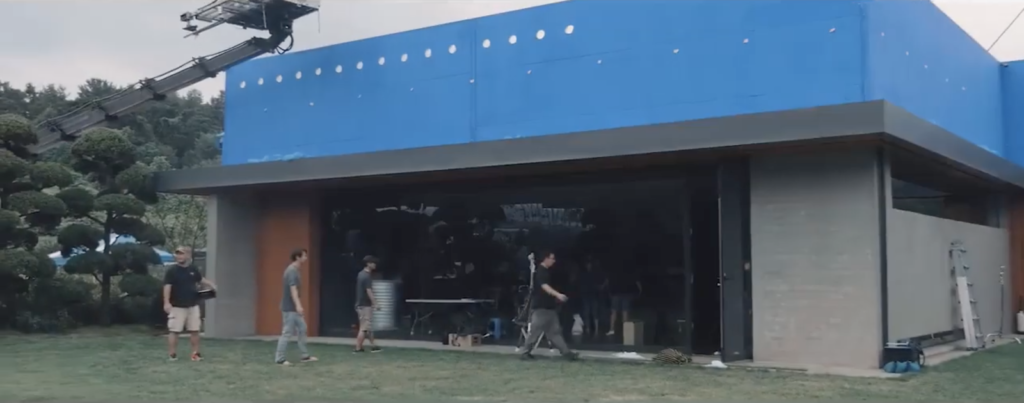There was a break in the snow and rain where the sun peeked through and gave us that crispy, saturated and blue light of early spring. It’s the kind of light that old painters spent decades of their lives perfecting but the planet just sort of carelessly throw into conversation ‘That? Oh that’s really nothing. Just a little something I learnt how to do near the poles.’
Thanks for giving me a break last week. It was all a bit much. It’s still all a bit much but I managed to carve out some time to write this and make that ↑. The idea with these sketches is that I’m looking to get faster at repetitive bits by making a library of models and materials I can reuse and template light set ups while experimenting with something new each time. This time I was using a noise texture across all the lights together as one material to generate the effect of them turning on and off in a noise-y way. I sort of intuitively knew how this might work and surprisingly it did. You can think of it like having a black and white generated picture of clouds that’s projected over the scene from above. When it touches anything that’s ‘light’ material it controls how bright they are. Where the picture is black, the lights are off and where it’s white they’re at 100.
I had a bit of an office upgrade this week. I’m in here 16 hours a day so I might as well make it as bearable as possible I got a bigger, higher monitor and have immediately noticed that I’m not stooping over the screen anymore, coiling up my shoulders. The curse of tall people is bad backs. I also got a multi-device mechanical keyboard which is smaller and means I don’t have to have two around for switching between the PC and Mac. I’m a bit wary here of falling into the mechanical keyboard rabbit hole, I have enough geeky hobbies.
Another benefit of this bigger screen is that I can actually keep my notes there ← while writing here. I didn’t realise how much tab switching I was having to do before. So, let’s get into it.
Reality + CGI = Hyperreality?

Not many people realise that most of Parasite is green screen. Almost all of the outdoor scene and even a bunch of the indoor scenes, particularly in the underground parts are all computer graphics. It’s sort of unexpected because the notion of ‘special effects’ lends itself to physically challenging phenomena like explosions, fights, falls and car chases; things that are risky or expensive to do in physical reality but relatively cheap in a computer. The idea that you might make extensive use of computer graphics for the first floor of a building, the end of a street and a tunnel seems a little ludicrous, especially when you consider that Jaques Tati built an entire city block for Playtime.
There’s an interesting tension here between suspension of disbelief and knowing. There’s no shock at the revelation that most of the Marvel franchise is shot on sound stages in front of vast green screen curtains. It’s a deception we’ve willingly bought into; a show or a performance. There’s something in the grit of a cinematic piece like Parasite where there is a feeling of being cheated. I suppose this circles back to my constant questioning of what realism is – it exposes this notion that computer graphics aren’t ‘real,’ that ‘reality’ doens’t need computer graphics and that their role is an aid to hyper-real phenomena; to elevate reality into hyper-real fantasy by compositing CGI onto it.
The other part of this of course is that the CGI in Parasite is exceptionally well accomplished and almost completely unnoticeable. It’s not used for big set piece battles or impossible physics. It’s just used to expand and frame the world, adding depth and form to the scenes. Here the CGI deepens and grounds the setting and the people, making scenes feel heavier or more alive rather than elevating them to a fantastical plane of massive explosions and impossible speed.
Short Stuff
- The smallest possible chance of a human being able to do anything is 3 x 1019. If 10 billion humans did the same thing every second for 100 years they’d do it that many times. Therefore 1 : 3 x 1019 is the smallest possible chance. Thanks to Matt Parker’s incredible mathematical analysis of a Minecraft speedrun for this bunch of statistical analysis fun and other.
- No thanks for Matt Parker (well, the YouTube algorithms really) for only getting this video about the maths of the black hole in Interstellar to me just under 24 hours after I’d finished recording a lecture about it.
- More on that generative mapping in Flight Simulator 5 – turns out people are modding Google Maps’ better scans in over the Bing ones.
- There were other things but… I’m going to save them because I want to keep this brief. I’ve got a really early start this morning and need to get going.
Ok, I love you , you knew that. I don’t need to tell you. Speak to you later, let me know if you want to chat before.